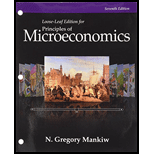
The consumer surplus and the producer surplus .
Answer to Problem 1CQQ
Option 'a' is correct.
Explanation of Solution
The
The maximum willing to pay price by the consumer for the massage here is $300. The actual price that the consumer pays after the negotiation between the two is $200. Since the difference between the maximum willing to pay price and the actually paying price is the consumer surplus, it can be calculated as follows:
Thus, the consumer surplus is $100.
Similarly, the minimum willing to accept price by the massager is $60 per hour and she spends 2 hours for the service, which totally costs $120, minimum. But the actual amount received by her is $200; this difference between the actual price received by the seller and the minimum willing to accept price is the producer surplus, which can be calculated as follows:
Thus, the producer surplus is $80.
Option (a):
Here, the consumer surplus is $100 from receiving the massage from the producer and the producer surplus is $80 by providing the massage service to the consumer. The difference between the consumer surplus and the producer surplus is $20. This means that the consumer surplus is higher than the producer surplus by $20 and hence, option 'a' is correct.
Option (b):
Here, the consumer surplus is $100 from receiving the massage from the consumer and the producer surplus is $80 by providing the massage service to the consumer. This means that the consumer surplus is higher than the producer surplus by only $20. But the given value in option 'b' is $40, which is twice the actual value. Thus, option 'b' is incorrect.
Option (c):
The consumer surplus is $100 from receiving the massage from the consumer and the producer surplus is $80 by providing the massage service to the consumer. This means that the consumer surplus is higher than the producer surplus by $20. Option 'c' points that the producer surplus is higher than the consumer surplus by the value of $20, which is inverse to the actual situation. Thus, option 'c' is incorrect.
Option (d):
The consumer surplus is $100 from receiving the massage from the producer and the producer surplus is $80 by providing the massage service to the consumer. The difference between the consumer surplus and the producer surplus is $20. The consumer surplus is $20 more than the producer surplus. Since option 'd' argues that the producer surplus is $40 larger than the consumer surplus, option 'd' is incorrect.
Concept introduction:
Consumer surplus: It is the difference between the highest willing to pay
Producer surplus: It is the difference between the lowest willing to accept price by the producer and the actual price that is received by the producer.
Equilibrium price: It is the market price determined by equating the supply to the demand. At this equilibrium point, the supply will be equal to the demand and there will be no excess demand or
Want to see more full solutions like this?
Chapter 7 Solutions
Bundle: Principles of Microeconomics, 7th + LMS Integrated Aplia, 1 term Printed Access Card
- You are the manager of a large automobile dealership who wants to learn more about the effective- ness of various discounts offered to customers over the past 14 months. Following are the average negotiated prices for each month and the quantities sold of a basic model (adjusted for various options) over this period of time. 1. Graph this information on a scatter plot. Estimate the demand equation. What do the regression results indicate about the desirability of discounting the price? Explain. Month Price Quantity Jan. 12,500 15 Feb. 12,200 17 Mar. 11,900 16 Apr. 12,000 18 May 11,800 20 June 12,500 18 July 11,700 22 Aug. 12,100 15 Sept. 11,400 22 Oct. 11,400 25 Nov. 11,200 24 Dec. 11,000 30 Jan. 10,800 25 Feb. 10,000 28 2. What other factors besides price might be included in this equation? Do you foresee any difficulty in obtaining these additional data or incorporating them in the regression analysis?arrow_forwardsimple steps on how it should look like on excelarrow_forwardConsider options on a stock that does not pay dividends.The stock price is $100 per share, and the risk-free interest rate is 10%.Thestock moves randomly with u=1.25and d=1/u Use Excel to calculate the premium of a10-year call with a strike of $100.arrow_forward
- Please solve this, no words or explanations.arrow_forward17. Given that C=$700+0.8Y, I=$300, G=$600, what is Y if Y=C+I+G?arrow_forwardUse the Feynman technique throughout. Assume that you’re explaining the answer to someone who doesn’t know the topic at all. Write explanation in paragraphs and if you use currency use USD currency: 10. What is the mechanism or process that allows the expenditure multiplier to “work” in theKeynesian Cross Model? Explain and show both mathematically and graphically. What isthe underpinning assumption for the process to transpire?arrow_forward
- Use the Feynman technique throughout. Assume that you’reexplaining the answer to someone who doesn’t know the topic at all. Write it all in paragraphs: 2. Give an overview of the equation of exchange (EoE) as used by Classical Theory. Now,carefully explain each variable in the EoE. What is meant by the “quantity theory of money”and how is it different from or the same as the equation of exchange?arrow_forwardZbsbwhjw8272:shbwhahwh Zbsbwhjw8272:shbwhahwh Zbsbwhjw8272:shbwhahwhZbsbwhjw8272:shbwhahwhZbsbwhjw8272:shbwhahwharrow_forwardUse the Feynman technique throughout. Assume that you’re explaining the answer to someone who doesn’t know the topic at all:arrow_forward
 Essentials of Economics (MindTap Course List)EconomicsISBN:9781337091992Author:N. Gregory MankiwPublisher:Cengage Learning
Essentials of Economics (MindTap Course List)EconomicsISBN:9781337091992Author:N. Gregory MankiwPublisher:Cengage Learning


 Economics (MindTap Course List)EconomicsISBN:9781337617383Author:Roger A. ArnoldPublisher:Cengage Learning
Economics (MindTap Course List)EconomicsISBN:9781337617383Author:Roger A. ArnoldPublisher:Cengage Learning





